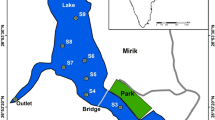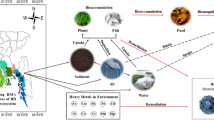Abstract
Chilka lake, the largest coastal lagoon of Asia is one of the most dynamic ecosystems along the Indian coast. Historically the lagoon has undergone a considerable reduction in surface area due, in part, to input from natural processes but mostly due to human activities. The purpose of this investigation is to document the heavy metals' affinity for specific geochemical phases in the recently deposited sediments in the lagoon. Thirty-three samples were collected and analyzed for different geochemical phases of Fe, Mn, Cu, Cr, Ni, Pb, and Zn utilizing a sequential extraction scheme. In the nonlithogenous fraction, the exchangeable fraction was not geochemically significant, having <2% of the total metal concentration for all the elements. However, the carbonate fraction contained the following percentages of the total concentration: <1% Fe, 13% Mn, 6% Cu, 4% Cr, 8% Ni, 13% Pb, and 12% Zn, suggesting the detrital origin of the sediments. Reducible and organic matter-bound fractions were the significant phases in the nonlithogenous fraction, containing 9% Fe, 16% Mn, 15% Cu, 16% Cr, 16% Ni, 14% Pb, and 14% Zn in the former and 4% Fe, 3% Mn, 17% Cu, 3% Cr, 14% Ni, 15% Pb, and 14% Zn in the latter. The phenomenon has been attributed to the scavenging affinity of Fe-Mn oxides and affinity for sorption into organic matter of the lagoon sediments. The lithogenous, residual fraction generally considered as a guide for natural background values was determined to contain 87% Fe, 67% Mn, 61% Cu, 77% Cr, 61.3% Ni, 56% Pb, and 60% Zn of the total concentrations.
Similar content being viewed by others
References
Abaychi JK and Douabul AZ (1986) Trace element geochemical associations in the Arabian Gulf. Mar Pollut Bull 17(8):353–356
Archer FC and Hodgson IH (1987) Total and extractable trace element contents of soils in England and Wales. J Soil Sci 38:421–431
Bengtsson L, Hellstrom T, and Rakoczi L (1990) Redistribution of sediments in three Swedish Lakes. Hydrobiologia 129:167–181
Bermond A and Sommer G (1989) Simulation of heavy metal extraction in soil samples compared with the experimental results. Environ Technol Lett 10:989–994
Breteler RJ and Saska FI (1985) The role of sediment organic matter on sorption-desorption reactions and bioavailability of mercury and cadmium in an intertidal ecosystem. In: Cardwell RD, Purdy R, and Bahner RC (Eds), Aquatic toxicology and hazard assessment. Proceedings Seventh Symposium. Philadelphia: American Society for Testing and Materials, STP 854, pp 454–885
Calmano W and Forstner U (1983) Chemical extraction of heavy metals in polluted river sediments in Central Europe. Sci Total Environ 28:77–90
Campbell PGC and Tessier A (1987) Current status of metal speciation studies. In: Patterson JW and Passino R (Eds), Metals speciation, separation and recovery. Michigan: Chelsea Lewis Publishers, p 201
Chester R and Hughes MJ (1967) A chemical technique for the separation of ferro-menganese minerals, carbonate minerals and adsorbed trace elements from pelagic sediments. Chem Geol 2:249–262
Copeland RA and Ayers JC (1972) Trace element distribution in water, sediment, phytoplankton, zooplankto and benthos of Lake Michigan: A baseline study with calculation of concern-factors and build up of radioisotopes in the food web. Ann Arbor, Michigan: Environmental Research Group. 271 pp
D'Itri FM (1990) The biomythylation and cycling of selected Metals and Metalloids in aquatic sediments. In: Baudo R, Giesy JP, and Mantau H (Eds), Sediment—chemistry and toxicity of in-place pollutants. Chelsea, Michigan: Lewis Publishers, pp 163–214
Elder JF (1988) Metal Biogeochemistry in surface-water systems: A review principles and Concepts. Denver, Colorado: US Geological Survey, Circular 1013. 43 pp
Elder JF (1994) Distribution and grain-size partitioning of metals in bottom sediments of an experimentally acudified Wisconsin lake. Water Res Bull 30:251–259
Elder JF and Collins JJ (1991) Freshwater molluscs as indicators of bioavailibility and toxicity of metals in surface water systems. Rev Environ Contam Toxicol 122:37–79
Farrah H and Pickering WF (1993) Factors influencing the potential mobility and bioavailability of metals in dried lake sediments. Chem Special Bioavail 5:81–96
Fernandes HM, Oliveira AE, Patchineelam SR, Cardosok K, and Holanda L (1991) Evaluation of the metal dynamics in sediments of a tropical coastal lagoon by means of radiotracers and sequential extractions. In: Kershaw PJ and Woodhead DS (Eds), Proceedings International Symposium on radionuclides in the study of marine process, Norwich. London: Eisevier p 383
Fernandes HM, Bidone ED, Veiga LHS, and Patchineelam SR (1994) Heavy metal pollution assessment in the coastal lagoon of Jacarepagna, Rio de Janeriro, Brazil. Environ Geol 85:259–264
Forstner U (1985) Chemical forms and reactives of metals in sediments. In: Leschber R, Davis RD, and L'Hermite P (Eds), Chemical methods for assessing bioavailable metals in sludges and soils. London: Elsevier. pp 1–30
Forstner U (1990) Inorganic sediment chemistry and elemental speciation. In: Baudo R, Giesy JP, and Mantau H (Eds), Sediment—chemistry and toxicity of in-place pollutants. Chelsea, Michigan: Lewis Publishers pp 61–105
Forstner U and Muller G (1974) Schwerme in Flussen und See. Berlin: Springer. 255 p
Forstner U and Salomons W (1980) Trace metal analysis on polluted sediments. Part I: Assessment of sources and intensities. Environ Technol lett 1:494–505
Forstner U and Wittmann GTW (1981) Metal pollution in the aquatic environment, 2nd eds. New York: Springer-Verlag. 481 pp
Gibbs RJ (1977) Transport phases of transition metals in the Amazon and Yukon Rivers. Geol Soc Am Bull 88:829–843
Harbridge W, Pilkey OH, Whaling P, and Swetland P (1976) Sedimentation in lake of Tunis: A lagoon strongly influenced by man. Environ Geol 1:215–225
Haung W, Campedon R, Abrao JJ, Bernat M, and Latouche C (1994) Variation of heavy metals in recent sediments from Piratininga lagoon (Brazil): interpretation of geochemical data with the aid of multivariate analysis. Environ Geol 23:241–247
Hong YT and Forstner U (1984) Speciation of heavy metals in Yellow River sediments. Proceedings, symposium on heavy metals in the environment. Heidelberg, pp 872–875
Horowitz AJ (1991) A primer on sediment-trace element chemistry, 2nd ed. Chelsea, Michigan: Lewis Publisher. 136 pp
Horowitz AJ and Elrick KA (1987) The relation of stream sediment surface area grainsize and composition of trace element chemistry. Appl Geochem 2:437–451
IUCN (1987) India. In: A Directory of Asian wetlands. Gland, Switzerland: International Union for Conservation of Nature (IUCN). pp 367–505
Jenne FA (1968) Controls on Mn, Fe, Co, Ni, Cu and Zn concentrations in soils and water: The significance of hydrous Mn and Fe oxides. In: Gould RF (Ed), Trace inorganics in waters. Advances in Chemistry Series 73. Washington, DC: American Chemistry Society, pp 337–387
Kheboian C and Bauer CF (1987) Accuracy of selective extraction procedures for metal speciation in model aquatic sediments. Anal Chem 59:1417–1423
Kjerfve B and Magill KE (1989) Geographic and hydrodynamic characteristics of shallow coastal lagoons. Mar Geol 88:187–199
Mallik TK and Suchindan GK (1984) Some sedimentological aspects of Vembanad Lake, Kerala, west coast of india. Indian J Mar Sci 13:159–163
Muller G (1979) Schwermettalle in den Sedimenten des Rheins: Veranderungem seit 1971. Umschau 79:778–783
Nadeau JE and Hall MJ (1988) Distribution pattern of metals in sediments of the Great Sound Complex, New Jersey. Mar Geol 82:113–122
Nair SM and Balchand AN (1993) Speciation of trace metals in sediments of a tropical estuary. Environ Geol 21:96–102
Nair SM, Balchand AN, and Nambisan PNK (1990) Metal concentration in recently deposited sediments of Cochin backwaters, India. Sci Total Environ 97/98:507–524
Nurnberg HW (1984) The voltametric approach in trace metal chemistry of natural waters and atmospheric precipitation. Anal Chim Acta 164:1–21
Oakley SM, Nelson PO, and Williamson KJ (1981) Model of trace metal partitioning in marine sediments. Environ Sci Technol 15:475–480
Paez-Osuna F, Botello AV, and Villanueva S (1986) Heavy metals in Coatzacoalcos estuary and Ostion lagoon. Mexico. Mar Pollut Bull 17:516–519
Panda D (1993) Texture, mineralogy and chemical composition of Chilka lake Sediments. PhD thesis (unpublished). Berhampur, India: Berhampur University. 222 pp
Paropkari AZ, Topgi RS, Rao CM, and Murthy PSN (1980) Distribution of Fe, Mn, Ni, CO, Cu and Zn in non-lithogenous fractions of sediments of Gulf of Kutch. Indian J Mar Sci 9:54–56
Pederson TF and Price NB (1982) The geochemistry of manganese carbonate in Panama Basin sediments. Geochim Cosmochim Acta 46:59–68
Rapin F (1984) Speciation of heavy metals in a sediment core from Baie de Nice (Mediterranean Sea). Proceedings, symposium on heavy metals in the environment. Heidelberg. pp 1005–1008
Rapin F, Tessier A, Campbell, PGC, and Carigan PR (1986) Potential artifacts in the determination of metal partitioning in sediments by a sequential procedure. Environ Sci Technol 20:836–840. Am. Chem. Soc. Publishers
Rendell PS, Batley GE, and Cameron AJ (1980) Adsorption as a control of metal concentrations in sediment extracts. Environ Sci Technol 14:314–318
Rose AW, Hawkes HE, and Webb JS (1979) Geochemistry in mineral exploration, 2nd ed. New York: Academic Press. 657 pp
Salomons W and Forstner U (1984) Metals in the hydrocycle. New York: Springer-Verlag. 349 pp
Sholkovitz ER (1989) Articrafts associated with the chemical leaching of sediments for rare-earth elements. Chem Geol 77:47–51
Shuman LM (1982) Separating soil iron- and manganese-oxide fractions for microelement analysis. Soil Soc Am J 46:1099–1102
Shuman LM (1985) Fractionation method for soil microelements. Soil Sci 140:11–22
Stumm W and Morgan JJ (1970) Aquatic chemistry. New York: Wiley-Interscience, 583 pp
Singh SK and Subramanian V (1984) Hydrous Fe and Mn oxides— scavengers of heavy metals in the aquatic environment. CRC Crit Rev Environ Control 14(1):33–90
Tessier A, Campbell PGC, and Bisson M (1979) Sequential extraction procedure for the speciation of particulate trace metals. Anal Chem 51:844–851
Tessier A, Campbell PGC, and Bisson M (1980) Trace metal speciation in the Yamaska and St. Francois Rivers (Quebec). Can J Earth Sci 17:90–105
Tipping E, Hetherington NB, Tilton J, Thompson DW, Bowles E, and Hamilton-Taylor J (1985) Articrafts in the use of selective chemical extraction to determine distributions of metals between oxides of manganese and iron. Anal Chem 57:1944–1946
Winfrey MR and Rudd JW (1990) Environmental factors affecting the formation of methylmercury in low pH lakes. Environ Toxic Chem 9:853–869
Zhang J, Huang WW, and Martin JM (1988) Trace metal distribution in Huanghe (Yellow River). Estuarine Coast Shelf Sci 26:499–516
Zonta R, Zaggia L, and Argese E (1994) Heavy metal and grain-size distributions in estuarine shallow water sediments of Cona marsh (Venice lagoon, Italy). Sci Total Environ 151:19–28
Author information
Authors and Affiliations
Rights and permissions
About this article
Cite this article
Panda, D., Subramanian, V. & Panigrahy, R.C. Geochemical fractionation of heavy metals in Chilka Lake (east coast of India)—a tropical coastal lagoon. Geo 26, 199–210 (1995). https://doi.org/10.1007/BF00770470
Received:
Accepted:
Issue Date:
DOI: https://doi.org/10.1007/BF00770470




